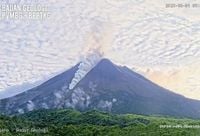Indonesia, a nation straddling the volatile Pacific Ring of Fire, has once again found itself in the global spotlight as a series of volcanic eruptions and heightened activity have swept across its archipelago in late September and early October 2025. With Mount Ibu in North Maluku erupting for the 28th time in just one week and a dramatic pyroclastic flow from Mount Merapi captivating viewers worldwide, the country’s ever-present volcanic threat is impossible to ignore.
According to the Center for Volcanology and Geological Hazard Mitigation (PVMBG), Mount Ibu erupted again on Thursday, October 2, 2025, at 23:32 WIT. This eruption is just the latest in a relentless series—28 eruptions have been recorded at Mount Ibu in the week leading up to this event. Seismic data from the same day paints a vivid picture of the mountain’s restlessness: 101 eruption or explosive earthquakes with amplitudes between 12 and 28 millimeters and durations of 32 to 74 seconds, three gust earthquakes, and 13 harmonic earthquakes, all adding up to a persistent rumble beneath the surface.
PVMBG has maintained Mount Ibu’s activity level at Level II (Alert), a clear signal that the volcano’s behavior is being watched closely. The agency has advised residents and tourists alike to steer clear of a 2-kilometer radius around the volcano, expanding to 3.5 kilometers toward the northern crater opening, where the risk is greatest. The warning is not just academic; with 2,343 eruptions attributed to Mount Ibu in 2025 alone, the threat is very real. Across Indonesia, MAGMA Indonesia has logged a staggering 6,508 volcanic eruptions this year, with Mount Semeru in East Java leading the count at 2,547 eruptions.
But Mount Ibu is not the only Indonesian volcano making headlines. Mount Merapi, perched on the border between Central Java and Yogyakarta, has been under heightened scrutiny since late 2024. The Balai Penyelidikan dan Pengembangan Teknologi Kebencanaan Geologi (BPPTKG), Indonesia’s geological research center, released a dramatic video on October 1, 2025, capturing a pyroclastic flow—an avalanche of hot gas and volcanic debris—racing 1,000 meters toward the Kali Putih river. The footage, which quickly went viral, underscores the persistent danger Merapi poses to the densely populated communities surrounding it.
Since late last year, Merapi has been at Level 3 alert, reflecting increased seismic activity and the growth of its lava dome. Multiple pyroclastic flows and frequent lava avalanches have prompted officials to maintain a strict 5-kilometer exclusion zone around the crater. BPPTKG’s video is more than just a spectacle; it’s a stark reminder of Merapi’s deadly potential, as seen in its catastrophic eruptions in 2010 and 2020. The volcano’s recent behavior, including multiple flows and ongoing seismicity in early 2025, has kept both authorities and residents on edge.
Indonesia’s volcanic woes are hardly isolated to these two giants. The Smithsonian Institution and US Geological Survey’s Weekly Volcanic Activity Report, published on October 2, 2025, highlights ongoing activity at 22 volcanoes worldwide during the week of September 24–30, including several in Indonesia. Alongside Mount Ibu and Mount Merapi, volcanoes such as Dukono, Semeru, Marapi, and Lewotobi have all displayed ongoing activity, ranging from ash plumes to seismic unrest. In fact, the report notes that new volcanic activity was also observed at Reykjanes in Iceland and Sabancaya in Peru during the same period, underscoring the global nature of volcanic hazards.
For Indonesia, however, the sheer frequency and scale of volcanic activity present unique challenges. The archipelago’s position atop the Pacific Ring of Fire—a horseshoe-shaped zone of tectonic activity stretching from the Americas to Southeast Asia—means that eruptions are a fact of life. The country’s 130 active volcanoes are among the most in the world, and their eruptions can have devastating consequences for local communities, agriculture, and even air travel. For example, the eruption of Lewotobi in late September led to the closure of Fransiskus Xaverius Seda Airport and the cancellation of six flights due to volcanic ash.
The human and economic costs of these eruptions are not lost on Indonesian authorities. PVMBG and the BPPTKG have ramped up their monitoring efforts, using seismic data, satellite imagery, and even viral videos to keep the public informed and safe. The agencies’ warnings are clear and direct: stay out of exclusion zones, heed evacuation orders, and remain vigilant. As the BPPTKG emphasized in its recent video release, “The raw power of nature and the tireless efforts of authorities to mitigate risks and protect lives” are on full display.
Yet, for many Indonesians living in the shadow of these volcanoes, the warnings are both a source of reassurance and anxiety. The memory of past disasters—such as the deadly Merapi eruption in 2010, which claimed over 300 lives—lingers in the collective consciousness. At the same time, the country’s advanced monitoring systems and rapid response protocols have saved countless lives in recent years, offering hope amid the uncertainty.
Indonesia’s volcanic activity also serves as a reminder of the broader geological forces shaping the planet. The Ring of Fire is home to 75% of the world’s active and dormant volcanoes, and eruptions like those seen at Ibu and Merapi are part of a much larger, dynamic system. Scientists continue to study these events, seeking to understand the triggers and warning signs of eruptions in the hope of improving forecasting and mitigation strategies.
International attention on Indonesia’s volcanoes is nothing new, but the immediacy of recent events—the viral video from Merapi, the relentless eruptions at Ibu, and the comprehensive reporting from organizations like The Watchers and the Smithsonian—has brought the issue to the forefront once again. As the world watches, Indonesia’s resilience and preparedness are being tested, and the lessons learned here may well inform volcanic risk management strategies far beyond its shores.
For now, life continues in the shadow of the volcanoes. Residents heed the warnings, scientists keep their instruments trained on the restless peaks, and the world waits to see what the Ring of Fire will do next.
